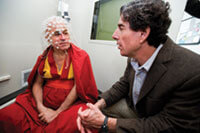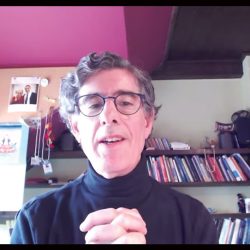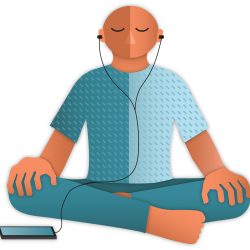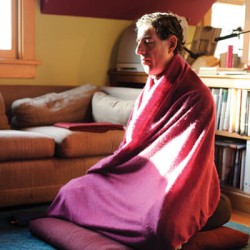Think Healthy

Richard Davidson (right) speaks with Buddhist monk Matthieu Ricard, who’s wearing a 128-channel geodesic sensor net in preparation for taking part in an electroencephalograph study. For several years, Davidson has been studying the brain waves of people who meditate. The new Center for Investigating Healthy Minds will combine high-tech brain imaging technology and space dedicated to contemplative practices under the same roof. Photo: eff Miller
The UW launches new center to study mindfulness and mental health.
The biggest minds in mindfulness, gurus both literal and figurative, came to Madison in May for the launch of the UW’s new Center for Investigating Healthy Minds (CIHM). The center’s grand opening included the Dalai Lama, along with University of Massachusetts medical professor and mindfulness advocate Jon Kabat-Zinn, and psychologist Daniel Goleman, author of Emotional Intelligence.
CIHM is devoted to studying ways in which contemplative practices, such as meditation, can change the human brain and lead people to greater mental health. Headed by Richard Davidson, professor of psychology and psychiatry and director of the UW’s Waisman Laboratory for Brain Imaging and Behavior, the center will involve researchers from a variety of fields, including the sciences and humanities.
“It’s highly interdisciplinary, going from the humanities to the hard sciences,” says Davidson. “We’ll be using modern methods of brain imaging, which will involve the work of physicists, computer scientists, and statisticians. But we also work with scholars in the humanities who practice mindfulness techniques. They provide the source and tradition to understand the texts that we furnish to people engaged in work here.”
One of the center’s focuses is on mindfulness — a technique in which practitioners fine-tune their attention to develop a fuller awareness of themselves and their surroundings. In recent years, Davidson has done neurological studies with Buddhist monks, finding that their heightened mindfulness appears to have a physical effect on their brains — an effect that can be observed using MRI brain imaging technology and EEG scalp recording to monitor patterns of brain activity.
As a result, the center becomes the first research facility in the world to combine both a brain imaging laboratory and a dedicated meditation space under the same roof.
Though its grand opening was in mid-May, CIHM has been laying the groundwork for research in a variety of areas. In addition to basic research, Davidson intends for the center to offer translational research — studies that could be immediately applicable to the community at large.
“We want to do real projects in a real context that make a real difference,” Davidson says.
Initial projects include a program with the Madison Metropolitan School District to teach secular mindfulness-based stress reduction techniques to elementary school teachers and students; a similar program aimed at four- and five-year-olds in campus preschools; an effort to work with returning veterans from the conflicts in Iraq and Afghanistan to help them with traumatic stress issues; and a possible program to work with the state’s corrections system to help released prisoners deal with the stresses of the transition back to everyday society.
An area of emphasis for the new center, says assistant scientist Lisa Flook, is its focus on healthy minds, rather than on mental illness. Those at CIHM believe that the techniques they study may help people learn to face stress in adaptive ways.
“The idea is that [mindfulness] can become a way of life,” she says. “We want to enable people to learn ways to cultivate healthy qualities of mind beginning in early life, which may prevent pathology later in life.”
Published in the Summer 2010 issue



Comments
Susan Fiore, B.M. '83, M.A. '86 June 4, 2010
This just might be the most important research happening today. I’m very excited about the public schools program.
Ross September 27, 2010
There are things we know, things we think we know and things that is left up to God. I think that we need to think and ask questions. The quest into the twilit zone is never ending. Hope will never die.